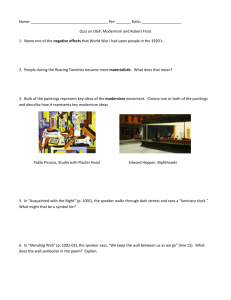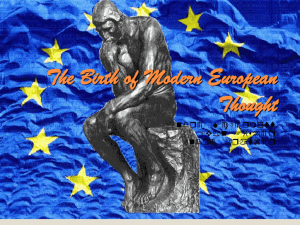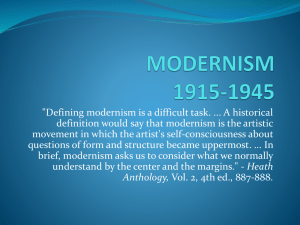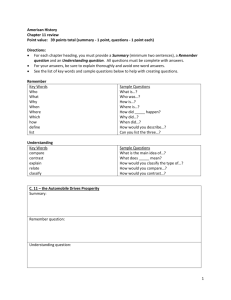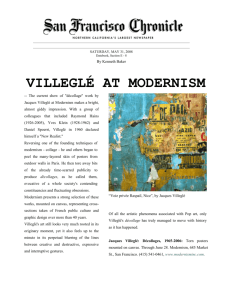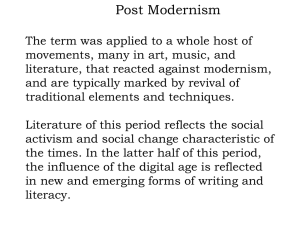Development of Modernism
advertisement
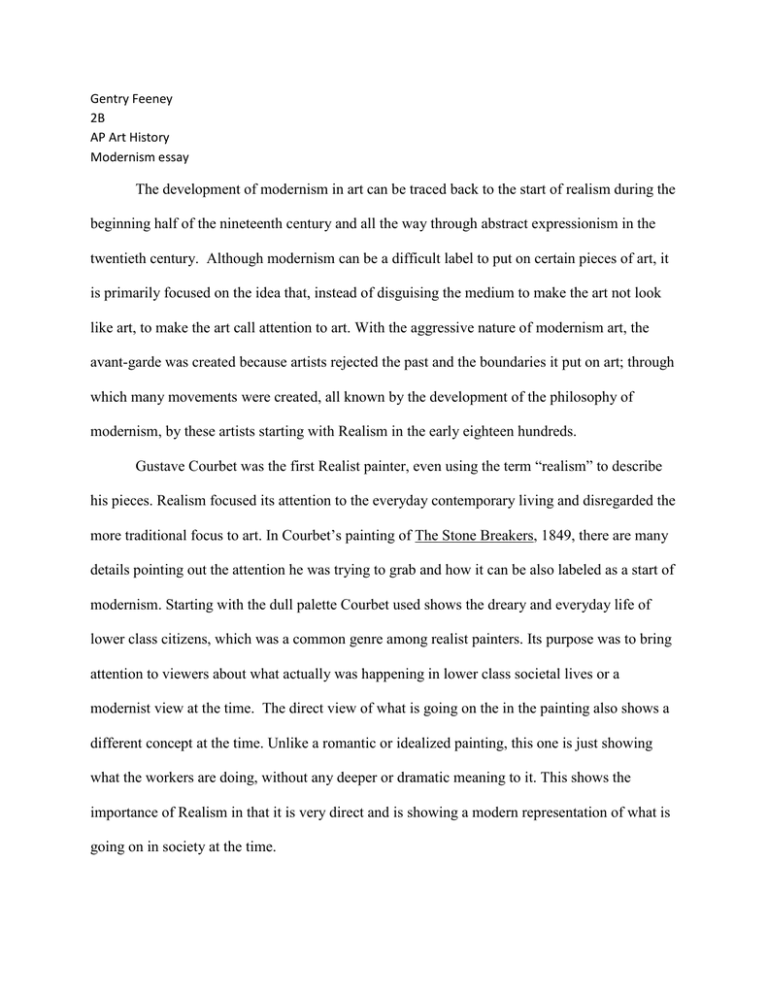
Gentry Feeney 2B AP Art History Modernism essay The development of modernism in art can be traced back to the start of realism during the beginning half of the nineteenth century and all the way through abstract expressionism in the twentieth century. Although modernism can be a difficult label to put on certain pieces of art, it is primarily focused on the idea that, instead of disguising the medium to make the art not look like art, to make the art call attention to art. With the aggressive nature of modernism art, the avant-garde was created because artists rejected the past and the boundaries it put on art; through which many movements were created, all known by the development of the philosophy of modernism, by these artists starting with Realism in the early eighteen hundreds. Gustave Courbet was the first Realist painter, even using the term “realism” to describe his pieces. Realism focused its attention to the everyday contemporary living and disregarded the more traditional focus to art. In Courbet’s painting of The Stone Breakers, 1849, there are many details pointing out the attention he was trying to grab and how it can be also labeled as a start of modernism. Starting with the dull palette Courbet used shows the dreary and everyday life of lower class citizens, which was a common genre among realist painters. Its purpose was to bring attention to viewers about what actually was happening in lower class societal lives or a modernist view at the time. The direct view of what is going on the in the painting also shows a different concept at the time. Unlike a romantic or idealized painting, this one is just showing what the workers are doing, without any deeper or dramatic meaning to it. This shows the importance of Realism in that it is very direct and is showing a modern representation of what is going on in society at the time. Modernism grew out of the beginning of Realism with the awareness of everyday life in different societal, mostly lower or middle, classes. Going along with the theme of the roots of modernism and everyday life in the lower classes, Edouard Manet paints Olympia in 1863. The flatness of this piece shows us that Manet was using the quote, “art to call attention to art,” showing the actual flatness of the canvas itself and how modernism was starting in this form of making art to look like art. The gaze of Olympia is very direct and somewhat not ashamed of what she is or has done, which was new to this time period in art. The painting of a nude woman, most likely a prostitute, caused tension through the art community because most nudes painted at the time were only of mythological subjects, so seeing an everyday woman being painted nude caused uproar. This modernist painting can be considered modernist because not only does it show the life of a lower class woman in everyday life, it is adding new techniques like allowing the brushstrokes to show more and creating a flattened image. As Realism focused primarily on the present time, another movement came to be focused more on an exact moment in time: Impressionism another part in the development of the philosophy of modernism in terms of art. Impression: Sunrise by Claude Monet, the noted founder of the movement, was the first impressionist piece. In this piece the idea of modernity and art looking like art is expressed in the quick, unrefined brush strokes of the water which makes it feel like actual water shimmering during the sunset. Another part of this piece which exhibits modernity is the painting of new subject manner. Many paintings could not have captured a sunrise because they are gone in an instant, but with the idea of quick movements and unrefined outlines, the scene of a sunset was captured. The whole painting itself was disliked by many critics for its visual lack of a finished product. Many thought this painting looked like a rough sketch, which was not considered “art” at the time period. Bringing the term modernism to its roots for art was supposed to look like art, not something else, but art. Exactly what Monet had done in his pieces. This brings forth the different techniques and subject matter that early modernist painters were not well liked for by the critics. Trying different things, like Monet or Manet did, caused tension through the critics because they were not sticking to the acclaimed school of art during the 1800’s. These artists and many more, are what helped create the philosophy of modernism in art throughout many years. Another artist famous for his use of modern techniques is PierreAuguste Renoir who created Le Moulin de la Galette in 1876. This painting shows the newly used idea of cropping the picture. In the far bottom left of the painting there is a half a girl who is sitting on a bench; in previous paintings that emphasized the correct way to do art the whole subject manner would be included in the painting, nothing would be cut off. This new way of painting that Renoir was doing lets the viewer know that there are more people in the scene, but didn’t have enough canvas to paint the entire thing, so he just cut them off short. A “modern” idea. In Le Moulin de la Galette the brushstrokes seem similar to those of Monet’s paintings; very rough and unrefined, which shows more movement in the piece. This diverged from old traditional paintings through the details in the faces of the people. The people in the foreground of the painting have somewhat defined facial features, but towards the background of the piece the facial features seem to just blend. Another modernist feature about this painting is the subject manner chosen; the middle class of France. It was a different approach to paint middle class citizens instead of upper class ones, but by having the viewer being able to relate to the painting is what the main focus was. Leading to the more emotional modern paintings, the idea of having the viewer react to the piece of art was demonstrated in the Symbolist movement. Edvard Munch tried to capture the emotional description of the modern psychic life in The Cry. Though impressionism captured the exact moment in time, symbolist painters tried to capture the fantasy world of their imaginations usually portraying symbols in their paintings. With the dejection of industrial and middle class genre paintings the Symbolists produced pieces from their minds usually in fantasy form. This takes on the fact that modernism was transforming into more of “art for art’s sake” through every movement because of the change of subject matter and meaning. The Cry, by Munch, shows the modern psychic life through the color and form of the lines throughout the piece. The man in the painting is in the real world, but his expression and the colors do not seem so. The bright warm colors show the emotional detachment from the piece because the bottom half is filled with cooler colors. The man is standing on the bridge with a horrified expression, making the viewer able to empathize with him. Symbolism was a part of modernism that changed the purpose to be able to make the art mean something, but still look like art. Moving past Symbolism and other art movements, many works became less and less meaningful, as in having an actual meaning behind the piece itself, but others still retained a meaningful subject matter. Kandinsky was the first to do a purely abstract piece of art, seeing as that material objects had no real substance and artists must express their spirit and inner most feelings by using color, line, and space. His works inspired many of the abstract expressionist artists, which later died down the hype of the philosophy of modernism in terms of art history. Jackson Pollock’s Number 1 was a pure action painting where the actual point of the painting was the process itself. Showing the transition from meaningful thought provoking paintings to a somewhat not meaningful painting, but the process was the point of the entire thing. Without a compositional scheme Pollock’s paintings aren’t meant to show a certain meaning by the artist, but by the viewer themselves to come up with a meaning. However, the colors of his paintings may have had a certain impact on what the viewer thought the meaning was to them. Modernism in terms of art history has changed from a more realistic provoking image with meaningful subject matter to a more artistic “art for art’s sake” sort of idea. From the point of Realism, artists’ purposes was trying to make art look more like art by making their works look like the medium they used and through Abstract Expressionism the artists were still doing the same thing. However, the change in the philosophy of modernism came from the viewer being able to interpret the art in different ways. With Realism and Impressionism artists had a particular subject matter which viewers interpreted the art as what it was, but with Expressionism and Abstract Expressionism artists created their art to be interpreted by people in individual ways instead of having a particular subject matter. From the early 1800’s to the mid-late 1900’s artists created pieces of work that can be defined as modernism through their subject matter, their motto that art needs to look like art, and ideas of emotional and psychological counterparts displayed in their art.
